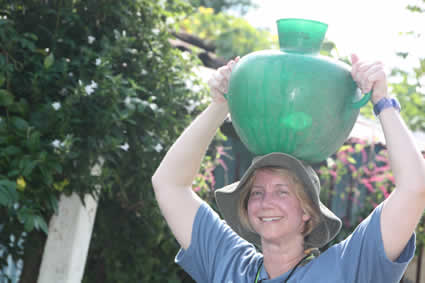I live in Broken Arrow, Oklahoma, a suburb of Tulsa. Last month I received an automated call from the city saying that two water samples had tested positive for E. coli but that no other tests had duplicated these results. According to the city, our water is tested 90 times each month to ensure that it is safe to drink.
In my average-size home I can turn on the tap at one of seven sources (not including the dishwasher, clothes washer or toilets) and water flows — both hot and cold.
Water is a non-issue for me. It is abundant, clean, and available without my even giving it thought. But that’s not the case for our sponsored children.

In October 2009, I traveled to El Salvador to meet one of my sponsored children, Bernardo.
As part of the trip I spent two days in Santa Maria Ostuma, El Salvador, home of the Compassion-assisted Columna y Baluarte de la Verdad child development center.
A group of us visited the home of Isabel, a woman in the community who has two children registered at the center.
We joined Isabel and her youngest child, Jasmine, as they walked down to the river to collect water. Little did we know what we were getting into!
The walk from Isabel’s home to the river took about 30 minutes. The view of the river was stunning, and most of the walk was down a very steep slope.
Upon reaching the river, I found a wash house where people gather to bathe. This is also where a pavilion is set up to wash clothes.
We learned that this water, like most water in the developing world, is contaminated and a cause of illness to the families who rely on it.
We filled our five-gallon water jugs from the river and, with each jug now weighing about 40 pounds, began trudging back up the hill to Isabel’s home.
Isabel placed her jug on her head and slowly but steadily walked up the steep path. The men in our sponsor group slung their jugs to their shoulders, while the women worked in pairs to lug the heavy jugs up the hill (which, with each step, seemed more like a mountain).

Finally, one of the women in our group tried carrying her water jug on her head. As I struggled up the hill, it seemed insane to place such a heavy jug on my head — especially without a pad like the local women use. But after my friend found this method easier, I decided to follow her example. Indeed, the jug was hard and heavy, but this was definitely easier than anything else I had tried.

I was able to slowly, steadily, step-by-step, make it the rest of the way to the top of the hill. When we finally reached Isabel’s house I had a real feeling of accomplishment, having contributed to the effort of bringing water to this family’s home. We all had a new understanding of walking in the footsteps of the poor, and a new appreciation of their daily task of fetching water.
So much time and energy is spent each day by Isabel and her children just doing what they must to survive. Gathering water and obtaining food is the main task of each day. There is little time or energy, let alone financial resources, to spend on school work or economic tasks such as developing a business.
If, instead of spending hours each day gathering water, these families were able to get water in only a fraction of that time, and if that water were clean rather than a cause of illness, just think of the difference it would make in their lives!
How much different would our lives be if we had to spend two to four hours each day just getting water to cook and do dishes?
Now, when I turn on my tap and reach for a cup of clean and safe water, I think of how fortunate I am. And I long for every Compassion-supported family to have this same blessing.
In the past I have contributed money toward “water projects” to help make this happen, but now I have a new understanding of just how important safe water is. Perhaps, in your next letter to your sponsored child, you can ask about his or her family’s water supply.
Do they have water in their home? If they go and fetch water, how far must they go? And is the water clean and safe, or contaminated?
ABOUT THE AUTHOR: Win Noren and her husband have been Compassion sponsors for 17 years. They sponsor seven children.







3 Comments |Add a comment
This is absolutely heart wrenching; the reality of what people have to do to survive and how much I as an American take for granted daily; when other countries would be ecstatic to simply have clean water.
Win I thank you for sharing this blog, it makes me re-examine all of my life’s blessings no matter how bumpy the course of life has been I now realize that someone would be happy to be in my shoes while I was yet whining and complain about it; what an eye opener!!
Your blog gives much more meaning to the Statement “I cried because I had no shoes, ’till I met a man who had no feet.”
Many Blessings
Thank you, Win Noren, for sharing your experiences and your pictures. I will not forget this new perspective. Lord bless you!
According to this website by Gospel For Asia, http://www.gfa.org/jesuswells/, a “Jesus well” can be purchased for $1000.
It is placed near the church, which also is near the Child Development Center. The time spent getting water is reduced significantly. Perhaps the family would benefit from an additional “safe water” filter system.
With less time devoted to water acquisition, there is more time for our children to attend school.